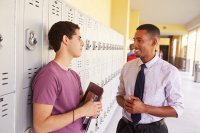How Restorative Justice Helps Students Learn
Restorative justice allows everyone affected by a harm to return to a calm state that is optimal for learning.
Your content has been saved!
Go to My Saved Content.Restorative justice (RJ) offers healthy alternatives to the traditional disciplinary approach of rules and the consequences of breaking those rules. RJ practices such as peer conflict resolution circles, reflection sheets that guide conversations with a teacher or administrator, and mediated student-student or student-adult conversations are practices that allow students and communities to feel safe and successful together.
While traditional rules-and-consequences discipline is sometimes effective in stopping detrimental behaviors, it may have negative effects on the long-term resilience and connection within the community. It’s worth considering the impact that such discipline has on our nervous systems, on the relationships within our schools, and on students’ identity and self-esteem, and what RJ has to offer as an alternative.
The Nervous System and Our Sense of Connection
Picture a student who has just passed a note in class or pushed a peer in the hallway and a teacher who has caught this student in the act. In this moment of rule violation and the confrontation that follows, the student, the teacher, and sometimes even nearby observers can experience a sympathetic nervous system response—muscular tension, an increase in heart rate, elevated levels of cortisol and adrenaline, and shortness of breath—also known as the “fight, flight, freeze, or submit” response. This is the body preparing to protect itself from a real or perceived threat or danger.
When a traditional rules-and-consequences approach is used to address errant behavior, the misbehaving student is often left to regulate their nervous system on their own—or not, as we see with students who transgress in the morning and then continue to act out or have a difficult time focusing throughout the day.
For an educator or administrator, it can be taxing when a student continues to act out and/or worrisome when a student begins to exhibit detrimental emotions and self-destructive behaviors. Simply punishing a behavior doesn’t allow for space to inquire about the motivation behind a misstep or what’s needed to repair the harm.
RJ practices help all community members involved to calm or regulate their nervous systems by focusing on authentic reconnection after a rupture occurs. When we’re connected, we naturally feel safer and our nervous systems have a better chance of returning to the parasympathetic “rest and digest” mode that is optimal for learning.
RJ practices allow us to recognize how the offender, victim, witnesses, and guiding adult are all impacted by the harm that occurred, and will all benefit from a reparative or restorative process to feel safe again in the school environment.
Applied in various ways, RJ practices always ask all parties involved:
- What happened?
- What harm was caused?
- What needs to happen to repair the harm?
Through RJ, students and adults learn about each other’s perspectives and build empathy and understanding, developing a greater sense of trust in one another. The transgressing student has the opportunity to repair harm by acknowledging their wrongdoing, expressing remorse, and taking action based upon the victim’s needs to repair trust. Victims are able to share their experience, offer forgiveness, and make amends. Having a chance to rebuild relationship after a misstep and to foster empathy, attunement, and accountability helps the whole community to feel safe and more connected.
No matter the level of severity of a rule violation—even when a student is asked to leave a community—the RJ process fortifies compassion and empathy for others and humanizes the experience of mistake-making.
Supporting Self-Esteem
When someone—a student or an adult—feels unsafe at home or experiences discrimination for their background, identity, or other reasons, they may come to school with an already overstimulated nervous system. This means it’s easier for them to become dysregulated—to experience a sympathetic fight, flee, freeze, or submit response—during a rule violation or enforcement moment.
Psychologically, a student who breaks a rule and receives punishment may begin to identify as a “bad kid,” and may be seen by their peers as someone who always get into trouble—a cycle that is sometimes repeated again and again. Through the reflective processes of RJ, this student can instead learn about the impact of their actions and reflect upon their membership in the community. They have a chance to grow self-esteem and to perceive themselves as a human who has made a mistake or bad decision and is taking responsibility for their actions.
Rather than simply doling out a punishment without guidance, RJ reminds us all that mistakes are learning opportunities for growth and that offenders have the opportunity to take responsibility for their behavior, repair the harm they have caused, and work toward a positive outcome.
A learning community that engages in connection building to repair harm becomes more resilient over time via more trusting connections between community members, increased self-awareness and compassion, and regulated nervous systems.
